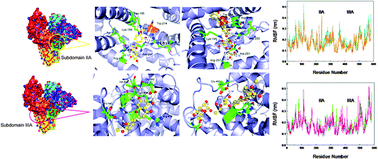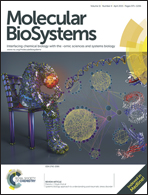Biological activity of natural flavonoids as impacted by protein flexibility: an example of flavanones†
Abstract
Naturally multifunctional Rutaceae hesperidin and its aglycone hesperetin have a great variety of biopharmaceutical activities, e.g. anti-cancer, anti-inflammatory, antioxidant and antitumor; however, the influence of the molecular structures of hesperidin and hesperetin, and in particular, the structural properties such as flexibility and dynamic features of protein on the biological activities of these bioactive compounds remains ambiguous. In the present study, the biomolecular recognition of crucial biopolymer – albumin from human serum (HSA) with Rutaceae, the recognition differences between HSA–hesperidin and HSA–hesperetin, the key elements that lead to the discrepancies as well as the structural characters of protein to the recognition processes were comparatively examined by employing biophysical approaches at the molecular scale. The results illustrated distinctly that (1) aglycone hesperetin can form stronger noncovalent bonds with HSA and possess higher recognition stability as compared with hesperidin. This phenomenon suggest that the introduction of glycoside structure into flavanone may possibly not be able to increase the noncovalent recognition of flavanone by a biopolymer, and conversely, this event will probably decrease the recognition capacity. (2) Although hesperidin and hesperetin can be located within subdomains IIA and IIIA, respectively, the conformational stability of flavanones in subdomain IIA is greater than subdomain IIIA; as a result, the recognition ability of subdomain IIIA with flavanones is patently lesser than subdomain IIA. These discrepancies likely originate from the unique characteristics of the respective cavity, or more specifically, subdomain IIA is basically a closed space, whereas subdomain IIIA is a semi-open region. Meanwhile, the detailed analyses of root-mean-square fluctuation interpreted the recognition of flavanones by subdomain IIA on HSA, which would evoke larger conformational alterations in several amino acid residues, and the similar phenomenon also resides in subdomain IIIA, which signifies that the flexible characteristics of different binding patches in protein may possess fairly notable effects on the HSA–flavanones recognition. Moreover, the integral structural changes of HSA exhibit some disparities on account of the dissimilarities of recognition capability to the protein–flavanone biointeractions, and all these conclusions received further forceful supports from fluorescence and circular dichroism experiments in solution. Perhaps the work emerged herein could not only help us to better evaluate the bioavailability of natural flavanones with or without glycoside, but to understand the sketches of the three-dimensional structure trait of certain biomacromolecules for the medicinal properties of flavonoids in the human body.

- This article is part of the themed collection: Chemical Biology in Molecular BioSystems

 Please wait while we load your content...
Please wait while we load your content...